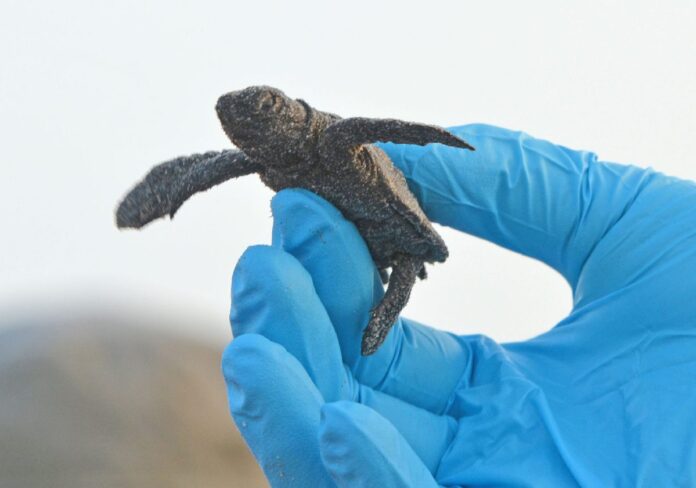SOUTH PADRE ISLAND — “Go babies, go.”
Those were some of the words of encouragement as well as energy and excitement of a large crowd that helped about 100 tiny, just hatched, sea turtles make it out to the ocean.
The scene was early yesterday morning during a public release of the Kemp’s Ridley sea turtle babies.
It’s hatching season and that means Sea Turtle Inc. is busy doing all it can to help the hatchlings improve their odds of a return to South Padre Island years from now to make their own nest and lay eggs as adults.
A total of seven nests hatched yesterday and two of those nests were released in front of a couple hundred people around 7 a.m. at County Beach Access No. 3, just north of Clayton’s.
The hatchlings that were released in public, made it out of their nest around 6:15 a.m. From there, Sea Turtle Inc. volunteers took them to the Sea Turtle Inc., facility, to check them out.
They were returned to the beach area in Styrofoam containers where a flood of people were waiting for their release, lined up along the beach.
Prior to putting them on the beach to head toward the rising sun, Sea Turtle Inc. personnel, with plastic gloves on, picked up the tiny turtles and showed them around up close to those there to see them and their release.
Then, the little turtles were poured onto the beach just steps from the waves rolling in and turned toward the sun to help aid them in their journey.
It took about 45 minutes for all of them to reach the ocean and be swept out in the waves.
When there were no more little turtles left on the beach, everyone in attendance clapped and cheered.
The other nests were released on the isolated northern beaches by trained staff members earlier.
Hatchlings can only be released when they are in an active state.
That is called “a frenzy.” When the hatchlings frenzy in the middle of the night, they are released to use the light of the moon to navigate from the beach to the ocean.
Staff said yesterday that restaurant and condo lights can confuse the babies, so they are taken further north away from that.
When the hatchlings frenzy at dawn, that is when the public releases are held.
The hatching process occurs over a couple days, according to Sea Turtle Inc.
Once the hatchlings have absorbed their yolk sac, they crawl upward toward the warmer temperature of the surface of the sand.
The sea turtle hatchlings usually emerge from their underground sandy nests under the cover of darkness.
Then, when a majority of hatchlings are on the surface, they make a synchronized frenzied rush to the awaiting surf. As they scurry across the sand, predators take many of the hatchlings.
But when there’s a public release, all the hatchlings make it to the water.
The hatchlings “imprint” on the beach as they walk out into the water. This refers to their ability to remember that specific beach and return to it as an adult sea turtle.
Once the baby turtles enter the water, they swim aggressively toward the origin of the waves, surfacing approximately every two minutes to breathe.
Less than 1 percent of the hatchlings will survive their first year.
Many animals in the water like crabs, fish, sharks and whales eat sea turtles.
Once the sea turtles reach maturity the cycle will begin again.
Depending on the species of sea turtle, it can take 15 to 30 years to reach maturity.
For the rest of this story and many other EXTRAS, go to our premium site, www.MyValleyStar.com.
Subscribe to it for only $6.99 per month or purchase a print subscription and receive the online version free, which includes an electronic version of the full newspaper and extra photo galleries, links and other information you can’t find anywhere else.




